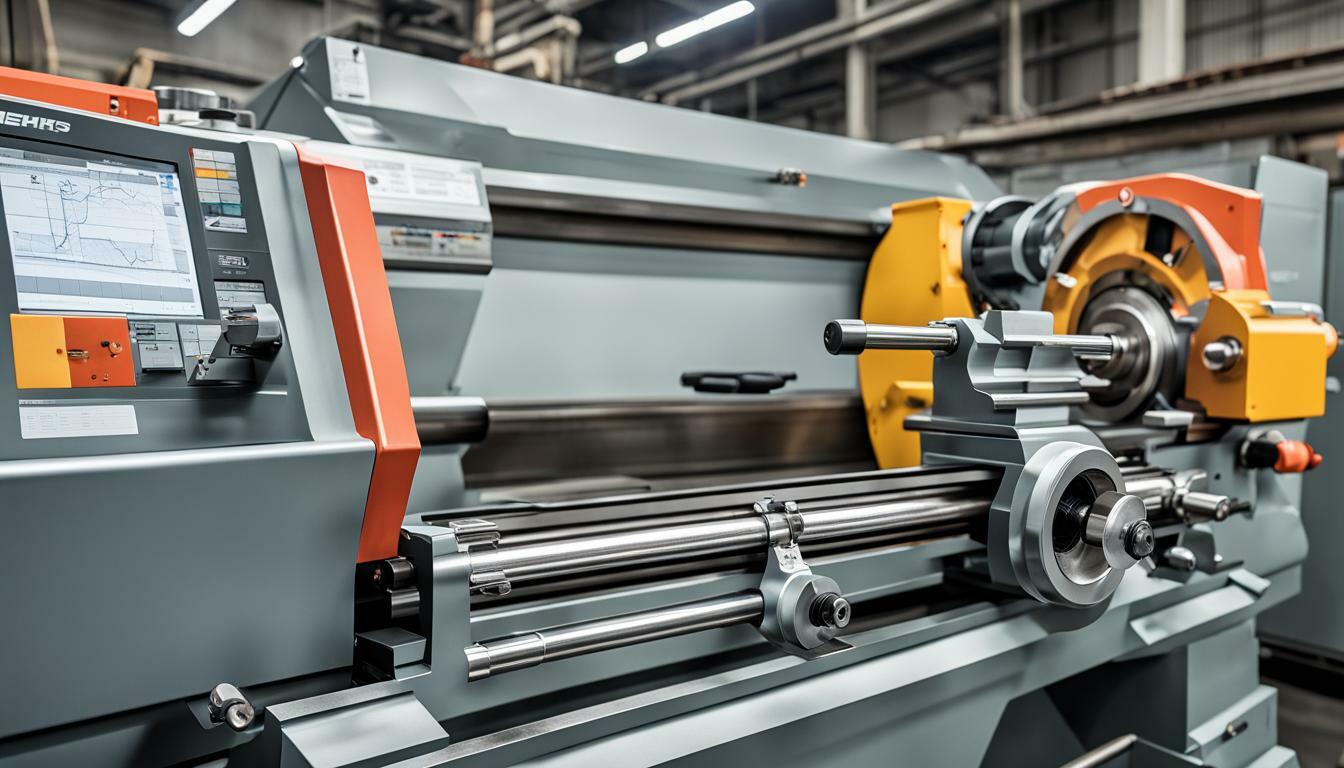
If you are looking to optimize the performance of your lathe machinery, it is crucial to have a comprehensive understanding of lathe feeds and speeds. This includes knowing the appropriate lathe cutting speeds and feeds and lathe machining speeds and feeds for different materials and cutting operations. Additionally, utilizing a lathe speed and feed calculator and referring to a turning speeds and feeds chart can greatly enhance accuracy, efficiency, and productivity.
In this article, we will provide a detailed guide on understanding lathe feeds and speeds charts. We will cover all the essential aspects of calculating feed rates, determining spindle speeds, and interpreting lathe feeds and speeds charts. By the end of this article, you will have a complete understanding of what it takes to optimize your lathe machinery for maximum efficiency.
Key Takeaways:
- Lathe feeds and speeds are crucial for optimizing the performance of lathe machinery.
- Understanding lathe cutting speeds and feeds and machining speeds and feeds is essential for achieving accuracy and efficiency in machining operations.
- A lathe speed and feed calculator and turning speeds and feeds chart can greatly enhance productivity by providing optimal settings for specific cutting scenarios.
Understanding Lathe Feeds and Speeds
Lathe feeds and speeds are critical factors that affect the performance and outcome of machining operations. The feed rate and spindle speed determine how fast the lathe cutting tool moves and how quickly the material is removed. To achieve optimal results, it is essential to understand how to calculate the lathe feed rate and select appropriate spindle speeds based on the material being machined.
Lathe Feed Rate Calculation
The lathe feed rate is the rate at which the cutting tool advances into the material being machined. It is typically measured in inches per revolution or millimeters per revolution (IPR or MPR). The feed rate affects the surface finish, chip size, and tool life. Calculating the feed rate involves knowing the cutting speed, number of teeth or edges on the cutting tool, and the desired chip load.
To calculate the lathe feed rate, use the following formula:
Feed rate (IPM) = number of cutting edges × chip load × RPM
Where:
- number of cutting edges is the number of teeth or edges on the cutting tool,
- chip load is the thickness of the chip produced during the cutting process, and
- RPM is the spindle speed in revolutions per minute.
Lathe Spindle Speeds
The spindle speed is the rotational speed of the lathe spindle and is measured in revolutions per minute (RPM). The appropriate spindle speed depends on the material being machined, the type of cutting tool, and the machining process. Generally, harder materials require slower spindle speeds to prevent excessive tool wear, whereas softer materials can be machined at higher speeds.
Recommended cutting speeds for lathes vary depending on the material and tool being used. As a general rule, carbide tools can be run at higher speeds than high-speed steel tools. The cutting speed is typically measured in surface feet per minute (SFM) and can be calculated using the following formula:
Cutting speed (SFM) = diameter × π × RPM ÷ 12
Where:
- diameter is the diameter of the workpiece being machined, and
- π is the mathematical constant pi (3.1416).
It’s worth noting that some materials may require lower RPMs to achieve optimal results, even if the cutting speed suggests otherwise. In such cases, it’s important to refer to a turning speeds and feeds chart or consult with a machining expert.
Using a Lathe Feeds and Speeds Chart
When it comes to utilizing a lathe machine for cutting operations, it’s crucial to have a good understanding of the feeds and speeds to achieve the desired results. A lathe feeds and speeds chart is a handy tool that provides the necessary information regarding the appropriate feed rate and spindle RPMs to optimize machining performance.
The chart includes a range of materials, cutting operations, and corresponding recommended feed rates and spindle speeds. By referring to the chart, you can select the appropriate feed rate and RPMs for the material and cutting operation you want to perform.
Reading and Interpreting the Chart
Reading a lathe feeds and speeds chart may seem daunting at first, but it’s relatively straightforward. The chart usually features columns that provide the material being cut and the cutting operation. The rows indicate the appropriate feed rate and spindle speed for each material and operation.
When using the chart, it’s essential to keep in mind the material’s characteristics, such as hardness and density, and the cutting operation you plan to perform. Adjusting the feed rate and RPMs based on these factors will help you achieve the desired outcome.
Adjusting RPMs and Feed Rate
It’s crucial to adjust the RPMs and feed rate depending on the material, cutting tool, and cutting operation when using a lathe machine. Generally, hard and dense materials require slower spindle speeds and lower feed rates to avoid any damage to the cutting tool or machine. On the other hand, soft and light materials require higher spindle speeds and feed rates to achieve desired results.
It’s important to note that the recommended feed rates and spindle speeds provided on the chart are a guide, and may require adjustments based on the specific job requirements.
Conclusion
When using a lathe machine for cutting operations, understanding and utilizing the lathe feeds and speeds chart can significantly enhance your machining performance. By taking the time to read and interpret the chart, adjusting RPMs and feed rate based on material characteristics and cutting operations, you can achieve accurate and efficient results.
Enhancing Accuracy and Efficiency
Accurate feed rate calculation is essential for achieving precision in lathe machining. The feed rate is the rate at which the cutting tool advances into the workpiece. The appropriate feed rate varies depending on the material being cut, the depth of cut, and the desired surface finish. A lathe feed rate calculator can help determine the best feed rate for a particular cutting operation.
Referring to a turning speeds and feeds chart is also crucial to achieving optimal results. The chart provides recommended cutting speeds for various materials, with faster speeds generally resulting in a smoother finish, and slower speeds producing better accuracy. The chart also indicates the appropriate feed rates and RPMs for specific cutting scenarios, helping to avoid damage to the workpiece and cutting tool.
When selecting the appropriate feed rate and RPMs, it is essential to consider the material’s characteristics. For example, softer materials like aluminum require faster speeds, while harder materials like steel require slower speeds. Additionally, the depth of cut and the complexity of the workpiece can impact the feed rate and RPMs, with deeper cuts generally requiring slower speeds to prevent overheating and buildup of heat.
Furthermore, it is important to note that feed rates and RPMs should be adjusted based on the desired outcome. For instance, if the primary goal is accuracy, a slower feed rate and RPMs may be preferable. Alternatively, if the goal is faster production, a higher feed rate and RPMs may be necessary.
Practical Tips
Here are some practical tips for selecting the appropriate feed rates and RPMs for your lathe machining operations:
- Refer to a turning speeds and feeds chart for guidance on the recommended parameters for various materials and cutting scenarios.
- Utilize a lathe feed rate calculator to determine the appropriate feed rate for a particular cutting operation.
- Consider the material characteristics, depth of cut, and complexity of the workpiece when selecting the appropriate feed rate and RPMs.
- Adjust the feed rate and RPMs based on the desired outcome, such as accuracy or productivity.
Conclusion
Lathe feeds and speeds charts are an essential tool for any machinist or lathe operator. By understanding the fundamental principles of lathe feeds and speeds, you can improve the accuracy and efficiency of your machining operations, leading to increased productivity and profitability.
Accurately calculating the feed rate and selecting appropriate spindle speeds for different materials and cutting operations is critical to achieving the desired outcomes. Referring to a comprehensive turning speeds and feeds chart can provide valuable insights into the optimal feed rates and RPMs for specific cutting scenarios.
As technology and materials continue to evolve, it is essential to stay informed about the latest advancements in lathe feeds and speeds. By continuing to learn and adapt, you can unlock the full potential of your machinery and stay ahead of the competition.
FAQ
Q: How do I calculate the lathe feed rate?
A: The lathe feed rate can be calculated by multiplying the spindle speed (RPM) by the number of cutting edges and the chip load.
Q: What are the recommended cutting speeds for a lathe?
A: The recommended cutting speeds for a lathe depend on the type of material being machined. It is important to refer to a turning speeds and feeds chart for specific recommendations.
Q: How do I use a lathe feeds and speeds chart?
A: To use a lathe feeds and speeds chart, you need to locate the material you are working with and the desired cutting operation. The chart will provide information on the recommended RPM and feed rate for optimal results.
Q: Why is adjusting the feed rate and RPMs important?
A: Adjusting the feed rate and RPMs is important to achieve desired outcomes such as surface finish, tool life, and chip control. Different materials and cutting operations require specific feed rates and RPMs for optimal results.
Q: How can understanding lathe feeds and speeds enhance accuracy and efficiency?
A: Understanding lathe feeds and speeds allows for precise feed rate calculation, resulting in accurate machining. Referring to a turning speeds and feeds chart ensures the selection of optimal parameters for efficient cutting and improved overall productivity.
- Delta Midi Lathe 46-250 Performance - August 27, 2023
- Understanding the Different Parts of a Lathe Machine - August 27, 2023
- Explore Different Lathe Tool Holder Types for Your Projects - August 27, 2023
